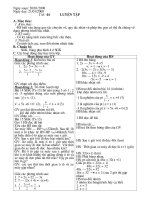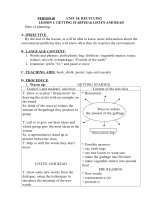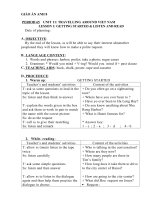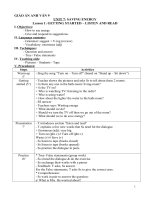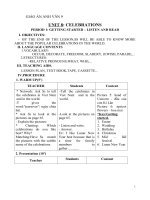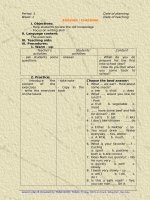Giáo án tiếng anh 8 Học kì II (Unit 10)
Bạn đang xem bản rút gọn của tài liệu. Xem và tải ngay bản đầy đủ của tài liệu tại đây (110.58 KB, 12 trang )
PERIOD 60 UNIT 10: RECYCLING
LESSON 1: GETTING STARTED & LISTEN AND READ
Date of planning:
A. OBJECTIVE :
By the end of the lesson, ss will be able to know some information about the
environment problems they will know what they do to prtect the environment
B. LANGUAGE CONTENT :
1. Words and phrases: cloth/plastic bag; fertilizer; vegetable matter; reuse;
reduce; recycle; overpackage; “Friends of the earth”
2. Grammar: prefix “re-“ and passive voice
C. TEACHING AIDS : book, chalk, poster, tape and cassette
D. PROCEDUCE :
1. Warm up: GETTING STARTED
Teacher’s and students’ activities Content of the activities
T: allow ss to play “ Brainstorm” by
drawing the circle with an example on
the board
Ss: think of the ways to reduce the
amount of thegarbage they produce in
group
T: call ss to give out their ideas and
which group giev the most ideas in the
winner
Ss: a representative stand up to
present before the class
T: help ss with the words they don’t
know
LISTEN AND READ
T: show some new words from the
dialogue, using the techniques to
introduce the meaning of the new
words
* Brainstorm :
Ways to reduce
the amount of the garbage
Reuse plastic bags
* Possible answers:
+ use cloth bags
+ use tree leaves to wrap smt
+ make the garbage into fertilizer
+ make vegetable matter into anomal
food …
PRE READING
* New words:
+ representative (n)
+ protect(v)
Ss: listen and note down the new
words
T: have ss read the words
T: introduce the content fo the
dialogue
Ss: listen to the teacher
T: give some True/False statements in
order for ss think to mark
Ss; read the statements and think to
mark T or F
+ natural resource(n)
+ recycle(v)
+ contact(v)
+ overpackage(v)
* Set the scene of the dialogue:
( use the instruction on the page 89)
* True or False statements:
1. Friends of the earth is an
organization to help people to make
friends with each other
2. Miss Blake asks the students
remember 3 things: reduce; reuse
and recycle
3. Reduce means buying some
products which are overpasckaged
4. We can not reuse things like
envelopes, glass, plastic bags and
plastic bottles
2. While- reading :
Teacher’s and students’ activities Content of the activities
T: ask ss to open their books, listening
to the tape while reading the dialogue.
T: call ss to give their choice and
others remark
Ss: think to do as the request
T: give correct answers with
explanation
Ss: listen and note down
Anser key: 1. F ; 2. T ; 3. F ; 4. F
* Comprehension questions:
a) Reduce means not buying product
which are overpackaged
b) We can things like envelopes,
glass, plastic bottles and old
plastic bags
c) Recycle means not just trhrowing
things away. Try and find another
use of for them
d) We can do it by contacting with an
organization like Friends of the
Earth, going to the local library or
asking your family and friends
e) ( student answers by themselves)
3. Post- reading :
Teacher’s and students’ activities Content of the activities
T: write the topic on the board and
ask ss to express their opinion on tis
topic
Ss: think to give the ideas
T: write students’ideas on the board
into a list
Ss: listen and then note down
T: give feedback, correct and ask ss to
copy
How to protect our enviroment?
4. HOME ASSIGNMENT:
T: ask ss to write the questions and full answers in your exercisebook. Do
exercises in the Work book . Prepare the next lesson “ Speak & Listen”
Ss: listen and note down
E. REMARK
PERIOD 61 UNIT 10: RECYCLING
LESSON 2: SPEAK & LISTEN
Date of planning:
A.
OBJECTIVE :
By the end of the lesson, help ss practice in giving and responding to
instructions and listening for specific information about making compost. They
can give and respond the instructions
B.
LANGUAGE CONTENT :
1. Words and phrases: fabric; leather; metal; compost; grain;
2. Skill : speaking and listening comprehension
C.
TEACHING AIDS : book, chalk, poster, tape and cassette
D.
PROCEDUCE :
1. Warm up:
Teacher’s and students’ activities Content of the activities
T: allow ss to play “Memory game”
show the picture on page 91 and then
let them look at it for 20” then put it
away. Devide the class into 2 groups,
going to the board to write the name
of things they remember in the picture
Ss: do as the request
T: tell ss the team with the most right
words is the winner
T: ask ss to take out their books and
look at the picture
Ss: listen and do as the request
•
Memory game
* Possible answer:
used paper; old newspaper; book;
bottles, cardboard boxes, glasses, jars,
plastic bags, food cans, drinking tins,
clothes, vegetablematter, shoes,
schoolbags
2. SPEAKING
Teacher’s and students’ activities Content of the activities
T: elicit from the students
Ss: give the words they don’t know
the meaning
T: explain by using the techniques to
introduce the words
Ss: listen and note down
T: tell ss to find the things in the heal
and then put them in correct group
Ss: think to find the name of the
words and put them in the correct
group
T: help them with the words they don’t
know
Ss; present before the class
T: put the map of the dialogue on the
board and then elicit the exchanges
from ss
Ss: look at the dialoge on the board
and then do similarly
T: call some good pairs of students to
present before the class
* New words:
1-
fertilizer
2-
compost
3-
fabric
4-
leather
* Dictation list:
Possible answers:
+ Paper: old newspaper, books,
cardboard boxes, …
+ Glass: bottles, glasses, jars
+ Metal : food cans , drinking tins
+ Fabric: clothes, cloth bags
+ Leather; shoes, sandals, schoolbags
+Vegetable matter: fruit peels, rotten
fruit…
•
Make diagues:
A: Which group do clothes belong to?/
What can we do with clothes?
B : Put them in fabric
C: Is/ Are fruit vegetable matter?
D : We make it into compost and
fertilize our field.
3. LISTENING :
Teacher’s and students’ activities Content of the activities
T: tell ss they are going to listen to an
expert who gives the instructions to
make compost
Ss: listen
T: ask them to open their books and
read the multipe choice qustions on
page 91. Check if Ss understand the
questions
Ss: try to understand the questions and
think to choose
T: play the tape twice
Ss: listen and do the exercise
T: call ss to give their choice
Ss: raise the hand to give the answers
T: call ss to remark and then play the
tape again to check
Ss; listen and then write the correct
answers
Answer key:
a- A
b- B
c- A
d- B
4. HOME ASSIGNMENT
T: practise the dialogue at home, replacing the information. Do exercise in the
Work book. Prepare the next lesson “ Read”
Ss: listen and then note down
E.
REMARK:
-------------------------------------------------------------------
PERIOD 62 UNIT 10: RECYCLING
LESSON 3: READ
Date of planning:
a.
OBJECTIVE :
By the end of the lesson, Ss will be able to form the passive voice in the
present. And read for detail about how things are recycled
B. LANGUAGE CONTENT :
1. Words and phrases: throw away, tire, deposit, milkman
2.Skill : reading comprehension and how to form passive voice
C. TEACHING AIDS : book, chalk, poster, tape and cassette
D. PROCEDUCE :
